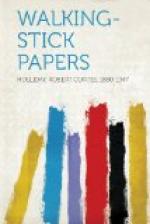That appealing spectacle, the girl who has performed somewhere in curiously home-made-looking “tights,” and, laughing roguishly at the camera, been photographed afterward (from this sight what roue would not turn away his sinful eyes in shame and pity?). The highly satisfied young man in the very rented-appearing evening clothes (photographed, it is apparent, in the day time). The blank-looking person who for some cryptic reason is enamoured of the studious, literary pose, and appears, in effect like a frontispiece portrait, glancing up from a writing table (an obviously artificial cigar between the fingers of one hand, apparently made of carbon, and, presumably, the property of the photographer). The aspiring amateur boxer, in position, with his sparing trunks on and an American flag around his waist (or sometimes, in default of trunks, he is seen in his nether undergarment). The jolly girl in boy’s clothes (who has not seen her?). The little child in costume performing a cute dance. The coloured beau, a heavy swell, in spats and a van Bibber overcoat. The gay banqueters of the So-and-So Association, around their festive board (one man, devilish fellow! holding aloft a beer bottle). The young girl in confirmation attire, standing awkwardly by a table (her slip of a mind, as she stands there, very probably less upon her God than upon her common, foolish dress). The team of amateur comedians (sad spectacle!). The bride and groom (perennial as the naked baby) standing, curiously enough, upon our old friend, the hairy rug. The family group (all the figures of which have a curious wax-work effect, reminiscent of the late Eden Musee). The policeman, in uniform (sitting in a chair of cathedral architecture). The fireman (a hero, perhaps,—though no man is a hero, merely amazingly human, to the cheap photographer’s camera). The youthful swains posed beside that indestructible stage property of the popular photographer, the artificial tree stump. The immortal woman vain of that part of her which Mr. Mantalini referred to as “outline,” and careful to keep her near arm from obstructing the spectator’s view (sometimes she is clothed; sometimes simply wound in a sheet; sometimes, in either case, she is like the Dowager whose outline Mr. Mantalini described as “dem’d"). All these—and many others—are the traditions of the cheap photography.
Nobody, apparently, is so unattractive, nobody so poor, nobody wears such queer clothes, nobody is so old, or faded, or fat, or “skinny,” or short, or tall, or black, or bow-legged, or so anything at all, that he or she won’t pose for a photograph. So that it may reasonably be said, that to have lost the instinct to have one’s “picture taken” is to have lost the love of life. Nobody, no doubt, but is interesting to somebody. And, as Stevenson has said, can any one be regarded as useless so long as he has a friend?
And when—brother—at length, one has withdrawn forevermore from the tawdry stage of the cheap photographer’s, a last view is taken of one, as it were, in the grave. Side by side at the cheap photographer’s with the naked baby and with the bride and groom—is the “floral emblem.”




